Quite a few universities have an official botanical garden (like UC Berkeley) or arboretum (like UC Davis), but there’s only one I know where the entire campus is dedicated to plants: Pitzer College in the Southern California town of Claremont.
 |
| Ocotillo (Fouquieria splendens) |
A private liberal arts college with about 1,100 students, Pitzer is part of the
Claremont Colleges, a consortium of five undergraduate and two graduate schools all located on one integrated campus about 35 miles east of downtown Los Angeles. The entire campus is about 1 square mile in size, so all the colleges are within walking distance of each other. Most of them have fairly traditional landscaping—lawn, shrubs and trees—but Pitzer is different. Very different. All of Pitzer is one giant succulent garden.
 |
| Beautiful clump of Agave titanota next to Amazon lockers |
The person who made it all happen is Joe Clements. The former curator of the Desert Garden at the Huntington in San Marino 25 miles up the road was hired by Pitzer College in 2000 as their grounds and arboretum manager. He immediately began to transform the conventional—and thirsty—plantings into a sustainable low-water landscape heavy on succulents as well as Mediterranean and California natives. (This
April 2010 article from Pacific Horticulture Magazine by well-known garden writer Nan Sterman has a wealth of background information.)
 |
| Lobivia formosa |
Today, virtually the entire campus of Pitzer College is part of
John R. Rodman Arboretum, named after an environmental studies professor who promoted environmental awareness as early as the 1970s. The Rodman Arboretum encompasses several different areas, including the
Outback Preserve, a living lab dedicated to restoring a rare alluvial fan sage scrub ecosystem on the edge of campus.
However, the main focus of my recent visit were the succulent-heavy plantings that dominate the central campus. According to a
press release from Pitzer College, the drought-tolerant gardens designed by Joe Clements have been called “the most sophisticated and artfully presented collection of succulents, desert plants, and Mediterranean-climate plants outside of a botanical garden.”
 |
| Cyphostemma juttae in front of ocotillo (Fouquieria splendens) |
Joe Clements retired in 2015, but his legacy lives on. The Pitzer College website has a number of photos taken and annotated by Joe Clements (
here), and many of the plants seen in these photos are still there—just much larger.
The campus of Pitzer College is small (34 acres), but there’s no reason larger university campuses couldn’t step up their game and convert what is often a drab and uninspiring landscape into something exciting.
 |
| Yucca rostrata and cardón (Pachycereus pringlei) |
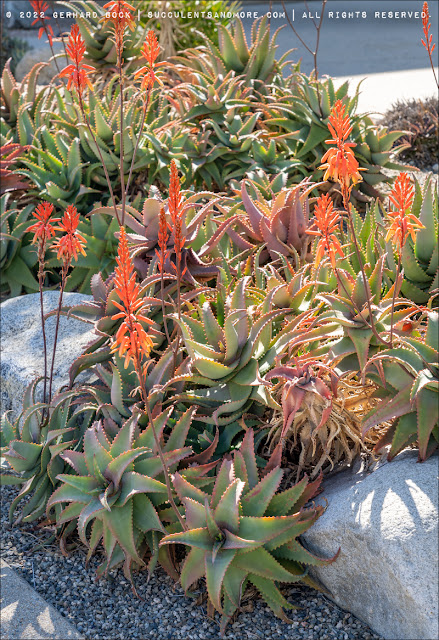 |
| Aloe elgonica |
 |
| Aloe suzannae |
 |
| Pitzer Multi-Species Negotiation Center, “a gathering spot [containing] a large map, a chalkboard for sharing information about foraging and an experimental irrigation/planting area designed to help propagate spontaneous migrant plant growth.” |
 |
| Euphorbia ammak ‘Variegata’ |
 |
| Aloidendron barberae |
 |
| Agave attenuata |
 |
| Dasylirion wheeleri |
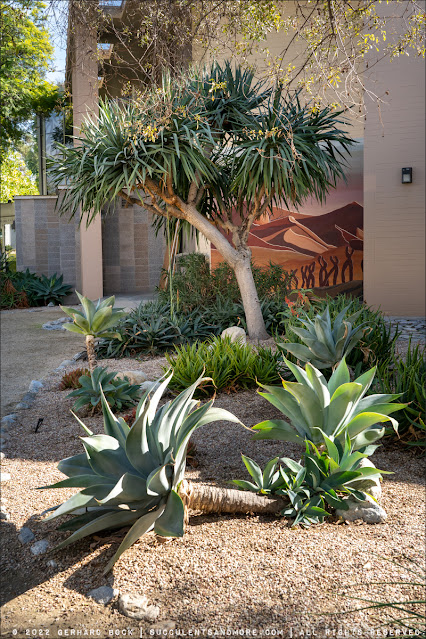 |
| Dracaena draco (back), Agave attenuata ‘Boutin Blue’ (front |
 |
| More Euphorbia ammak ‘Variegata’ behind the bicycles |
 |
| Pachypodium lamerei |
 |
| Lots of Echinopsis hybrids in many places on campus; they must be spectacular when in flower |
 |
| Large ponytail palm (Beaucarnea recurvata) in front of Grove House |
 |
| The largest Agave attenuata ‘Variegata’ I’ve ever seen |
 |
| More Echinopsis in a large planter |
 |
| Pachypodium lamerei (tall) and Euphorbia millii (low) |
 |
| Pachypodium lamerei is native to Madagascar; its flowers are typical for the dogbane family (Apocynaceae) and similar to relatives such as oleanders and plumerias |
 |
| More Pachypodium lamerei |
 |
| Mexican fencepost cactus (Lophocereus marginatus) in a sea of Graptopetalum paraguayense |
 |
| Euphorbia ammak ‘Variegata’ |
 |
| Another Aloidendron barberae and more Echinopsis species or hybrids |
 |
| Pitzer Hall Rooftop Garden (plant IDs here) |
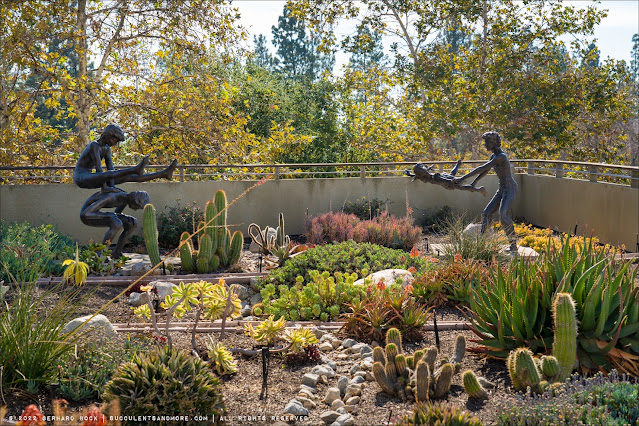 |
| Pitzer Hall Rooftop Garden (plant IDs here) |
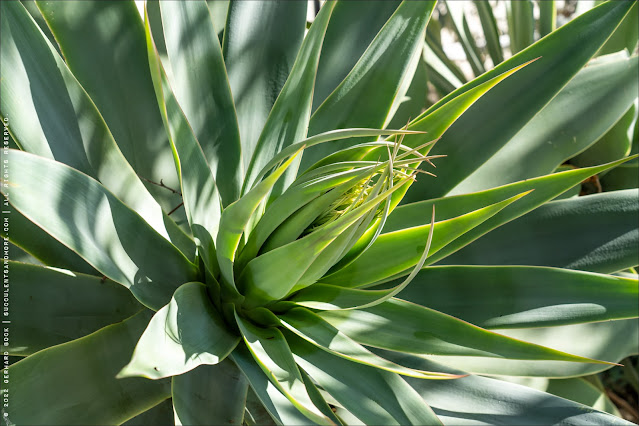 |
| Agave attenuata flower stalk starting to emerge |
 |
| Another Agave attenuata flower stalk, further along |
 |
| Palm trees and agave flower stalk |
 |
| Bulbils on flower stalk of Agave angustifolia ‘Marginata’ |
 |
| Pilosocereus pachycladus (left) and Aloe ferox (right) |
 |
| Aloidendron dichotomum and Lophocereus marginatus |
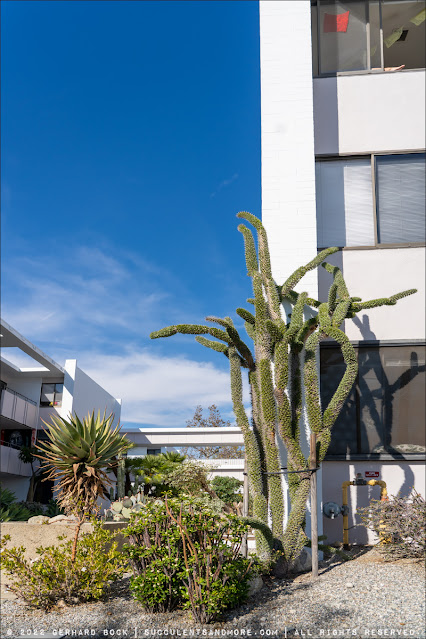 |
| Alluaudia procera |
 |
| Euphorbia ammak ‘Variegata’ |
 |
| Euphorbia ammak ‘Variegata’ |
 |
| Aloidendron ramosissimum |
 |
| Aloidendron dichotomum, a close relative of A. ramosissimum |
 |
| Trio of Agave attenuata |
 |
| Yucca rostrata (left) and Epostoa lanata (center); the tree with the pinkish seed pods is Koelreuteria paniculata |
 |
| The largest Aloe suzannae I saw at Pitzer College |
 |
| “Be your own weird,” I couldn’t think of a better motto |
I was wondering about the climate of Claremont, which is located fairly far inland. Based on the plants that thrive on the campus of Pitzer College, Claremont must rarely, if ever, get frost. And that seems to be the case. Claremont is in
USDA hardiness zone 10a, or
Sunset zone climate zone 19 (“Thermal belts around Southern California’s interior valleys”). The average precipitation is 17.32 inches according to
Wikipedia. Personally, the sounds like a pretty dreamy climate to me!
© Gerhard Bock, 2022. All rights reserved. To receive all new posts by email, please subscribe here.















































What a gorgeous campus to go to school in. Pitzer could definitely be an example for others to up their game. Some really gorgeous plants there but the roof top garden is especially good. What is the college's main educational focus?
ReplyDeleteAccording to their website, "Pitzer College produces engaged, socially responsible citizens of the world through an academically rigorous, interdisciplinary liberal arts education emphasizing social justice, intercultural understanding and environmental sensitivity. The meaningful participation of students, faculty and staff in college governance and academic program design is a Pitzer core value."
DeleteWow. Lucky students! They must enjoy hanging out with all those cool plants during breaks from lessons. Love your pic of Pachypodium lamerei with the shadow on the building - that plant has personality.
ReplyDeleteAs I was walking around, I was wondering if students really know _how special_ this campus is. I hope so...
DeleteAnother place I've never visited (despite the fact that I live much closer to it than you do!). I love that roof-top garden. I can't even imagine a college consisting of only 1100 students - my high school graduating class was larger than that. That's beside the point but it's interesting that Pitzer has invested as much as it has in its landscape and its unique student culture. I can't say as much for the much larger universities I attended as an undergrad and a grad student.
ReplyDeleteThe rooftop garden is one of the newer installations.
Delete1100 students isn't a lot, agreed. That is one reason why the quality of education is so high at Pitzer--and why it's so expensive (_tuition alone_ is $60,000 a year). Acceptance rate is about 18%.
Oh, my goodness, thank you for this tour! Marvelous! I was amazed at so many plants! The Cyphostemma juttae, the Agave attenuata ‘Variegata’, the Aloe suzannae just to name a few! Such an ideal climate for all these plants.
ReplyDeleteIt's such a special place! Only a small but wealthy liberal arts college in a drought-stricken place would think to do this!
DeleteCreating this spectacular garden is a forward thinking initiative. It's hard to see how any southern CA outdoor space justifies the maintains of a large lawn.
ReplyDeleteI'm particularly blown away by the Pitzer Hall Rooftop Garden. With tree tops surrounding the rails, it's a little piece of heaven.
Chavli
I love it when institutions invest in what others may see as a waste of money. The mental health benefits for students who see this kind of landscaping every day are priceless.
DeleteLargest Aloidendron ramosissimum I've seen. Impressive! Does the growth habit of Aloe 'Moonglow' remind you of A. suzannae at all? Can't imagine that species being used in hybridizing, but the resemblance is there somehow.
ReplyDeleteMr. Clements did a wonderful job.
The parentage of Aloe 'Moonglow' is proprietary information, apparently. It could definitely have Aloe suzannae in it. I'd love to know, actually.
Delete